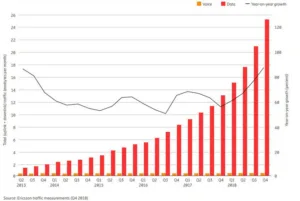When he heard I was working on a 5G Display Daily, Ken Werner asked me “If you can think of any potential applications that would actually sell more displays, that would be a good addition for the DD.” Ken actually has reversed cause and effect. 5G won’t drive the sales of displays, the sales of displays has driven the need for 5G.

If you use your mobile telephone to talk to people, you will see no benefit from being on a 5G network compared to a 4G, 3G, 2G or even an analog 1G cellular system. Other than an occasional text message which I couldn’t have done on a 1G system, that’s a good description of me. Of the more than 100K attendees at CES last time I was there, I believe I had the oldest, most primitive flip phone on the show floor. It still had a stub antenna on it. That one has since died, so I needed to get a new phone – another flip phone.
Voice Traffic compared to Data Traffic on mobile networks (Credit: Ericsson)
However, I am aware I am not a typical smartphone user. As shown in the figure from Ericsson, the traffic on mobile cellular networks is overwhelmingly data traffic, not voice traffic. Voice traffic volume has been essentially stable in the 2013 through 2018 time frame, as shown in the figure. While the year-over-year growth of data traffic has varied, it has never been less than 50% and has reached highs of nearly 90% in some quarters. While the figure ends in Q4 2018, this trend shows no sign of abating and data traffic is expected to continue to grow compared to voice traffic. Mobile Data Traffic per Month in 2018 and 2024 (Credit: Ericsson)
Mobile Data Traffic per Month in 2018 and 2024 (Credit: Ericsson)
Everyone seems to have a strong appetite for video. (I watched a live video of my grandson eating breakfast yesterday on my wife’s smartphone.) Not only video but high resolution video to go with their 1080P, QHD, Retinal and 4K displays, with 8K displays on the horizon. According to Ericsson, video represents 60% of the 27 Exabytes of data traffic per month today (1 Exabyte = 1 million Terabytes). By 2024, Ericson expects video to take a larger share, 74%, of a much larger pie, 136 Exabytes. All data traffic, including video, will grow at a 31% CAGR. Looking at just the video traffic, 16 Exabytes in 2018 is expected to grow to 101 Exabytes in 2024, for a CAGR of 36%. That’s an awful lot of kitten and grandson videos. 5G networks are seen as a way to increase network capacity to meet this need for high resolution video and other applications.
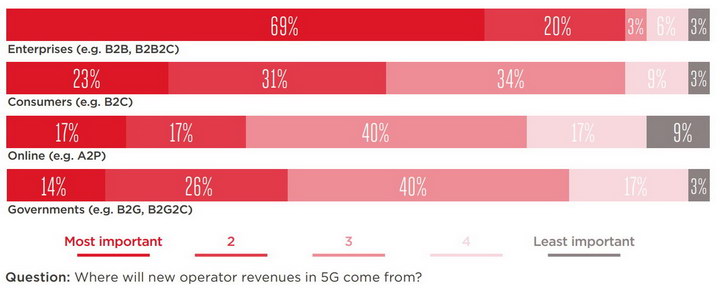 GSMA Survey of Network Operators on new 5G revenues. (Credit: GSMA)
GSMA Survey of Network Operators on new 5G revenues. (Credit: GSMA)
Bob Raikes, in his Display Daily on 5G, said that the revenue growth for network providers is expected to be about a 2.5% CAGR through 2025. Clearly, the cost per Exabyte for data on the networks must decline rapidly in the coming years to allow network providers to amortize the high cost of installing a 5G network and make a profit. Still, it is expected that new revenue will be needed. In a GSMA survey of network operators, the belief is much of this new revenue will come from enterprise use of 5G, not consumer use, as shown in the figure above. I wrote a Display Daily titled “5G and the Red Queen’s Race” in February that covered some additional business aspects of 5G. Perhaps the most serious part of the 5G “Race” is the race to profitability rather than a race to install 5G networks, although it is possible the first network to convert to 5G will gain enough customers to pay for it.
In a second DD of mine titled “Boundless Enthusiasm for 5G NR” I pointed out that the current version of 5G is carried by two different radio frequency bands. The one that gets all the hype about super-high download speeds is called mmWave (commonly spelled as one word, sometimes two) and is at radio frequencies greater than 28GHz. The second RF band is commonly called the sub-6GHz band or just sub-6. The original 5G specification included only the mmWave band. The more recent 5G NR specification includes both the sub-6 band and the mmWave band. The “NR” in 5G NR stands for “New Radio” but that’s really a misnomer. The sub-6 band, especially the region from 600MHz to 3.6GHz, is the RF region currently occupied by 4G and earlier cellular services and has been in use for decades. I guess the 3GPP, the group that seems to be in control of the 5G specifications, didn’t want to name the new spec 5G OR for “Old Radio.”
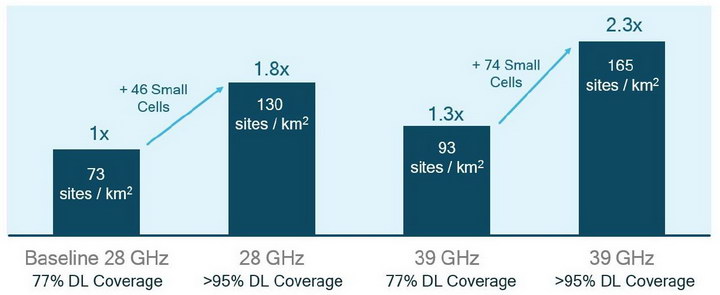 Site densities needed for 5G mmWave coverage. (Credit: Qualcomm)
Site densities needed for 5G mmWave coverage. (Credit: Qualcomm)
The mm Wave band has a lot of problems associated with it. First and foremost, it is very short range. I’ve seen estimates that mini-cells will need to be spaced 100 – 150m apart to ensure 100% coverage. The telephone poles on my block are spaced roughly 38m apart. To ensure 100% coverage of this street, one phone pole out of three would need to have a mmWave transceiver on it. Maybe this can be done in dense, high-value areas (to network providers) like San Francisco or Manhattan, but it’s not likely to happen in more ordinary areas and just can’t happen in rural areas. T-Mobile is planning on a nationwide 5G network in the 600MHz band. This band is the lowest frequency, longest range but lowest data carrying capacity of any US cellphone band.
Another problem with the mmWave band is it doesn’t penetrate anything, If there is a tree between you and the mmWave transceiver, you might get a signal in the winter when there are no leaves on the tree but probably wouldn’t get a signal when the tree leaves fall. This also means that the mmWave band will provide no indoor coverage with outdoor cells. 5G has been proposed as a vehicle for the very high data rates needed for immersive, high resolution VR. To get these data rates, you will need to take your VR headset outside to a place where you can see a mmWave mini-cell on your neighborhood telephone pole.
These problems with mmWave mean that it will be necessary to have a much higher density of cell sites to provide good coverage. In a Qualcomm study, if you are working with the low-end of the mmWave band, 28GHz, you need 73 cell sites/km² to get about 77% coverage or 130 sites/km² to get >95% coverage, as shown in the figure. If you are at the far end of the mmWave band, 39GHz, the problem is worse with 93 and 165 sites/km² respectively.
When somebody says to you “5G” you should be hearing “5G NR.” With the sub-6 band of 5G NR, you should get outdoor and indoor coverage just as good as you get with 4G or, for that matter, with the large installed base of 2G networks. Relatively few 3G networks were ever built, compared to 2G and 4G.
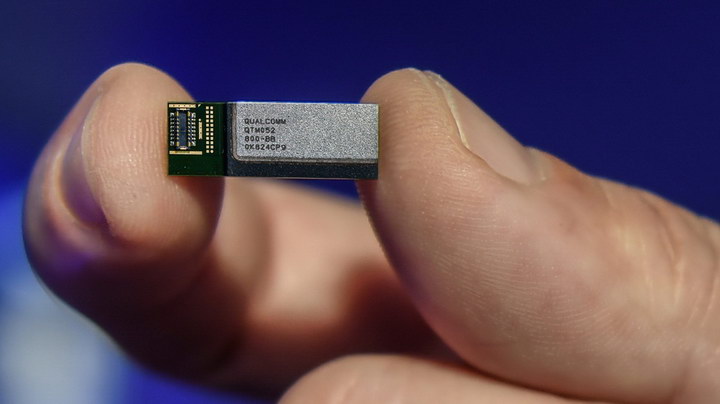 Qualcomm’s QTM 052 steerable antenna module. Qualcomm says four of these antennas will fit in a smartphone, all driven by a single Qualcomm RF modem chip. (Credit: Qualcomm)
Qualcomm’s QTM 052 steerable antenna module. Qualcomm says four of these antennas will fit in a smartphone, all driven by a single Qualcomm RF modem chip. (Credit: Qualcomm)
So is 5G a waste of time, money and hype? The short answer is no. 5G on the sub-6 band improves on 4G by being able to transmit more data per unit bandwidth than most versions of 4G do, due to better, more efficient encoding. The OFDMA (Orthogonal Frequency-Division Multiple Access) RF modulation scheme used by 5G is also said to be less sensitive to multi-path problems than the OFDM (Orthogonal Frequency-Division Multiplexing) RF modulation scheme used by 4G and LTE networks.
This encoding improvement does not provide the 100x improvement that the 5G hype promises, but a more modest 1.5x – 4x, depending on the version of the 4G service it is compared to. The 100x improvement comes with mmWave. mmWave, with all its problems, still has its uses. mmWave is fundamentally a poor choice for mobile communications, although modern beam-steering antennas and other technology fixes largely overcome these problems. There is no technology solution for its short range – the network operator needs to install a lot of cells.
 Verizonn 5G Home may eventually replace your fiber to the home access. (Credit: Verizon)
Verizonn 5G Home may eventually replace your fiber to the home access. (Credit: Verizon)
Question: What is 5g mmWave especially good for? Answer: Fixed Wireless Access (FWA). Much of this FWA will be business or government-related, not consumer-related. However, Verizon is testing 5G mmWave FWA in the consumer space as a high speed alternative to copper or even fiber to the home (Verizon’s FIOS). A 5G mmWave microcell on a telephone pole can provide high-speed network access to several nearby homes, providing Internet, TV and voice services over one wireless connection. On the outside the house you install a mmWave transceiver connected to a high-speed Wi-Fi system inside the house. With no wires or fiber cables for Verizon to install or maintain between your home and the pole, you get a higher capacity system with even higher data rates than with fiber to the home. At least, these higher data rates are theoretically possible – time will tell if they are actually achieved in the field.
 Survey of Network Operators on the roadmap for 5G (Credit: 451 Research, commissioned by Vertiv)
Survey of Network Operators on the roadmap for 5G (Credit: 451 Research, commissioned by Vertiv)
So when will you get 5G? The figure shows the answers to a survey done by 451 Research for Vertiv of 105 network operator technical executives to the question. Some operators (12% of respondents) will have started on their 5G network coverage in 2019. 4% expect to have 100% coverage by 2023 – 2024, an additional 28% expect 100% coverage in 2025 – 2027, and 68% of the operators don’t expect full coverage till beyond 2028. So if you buy a 5G phone today, most of the time you will be using it on a 4G, 3G or 2G network, unless you keep your phone until after 2028.
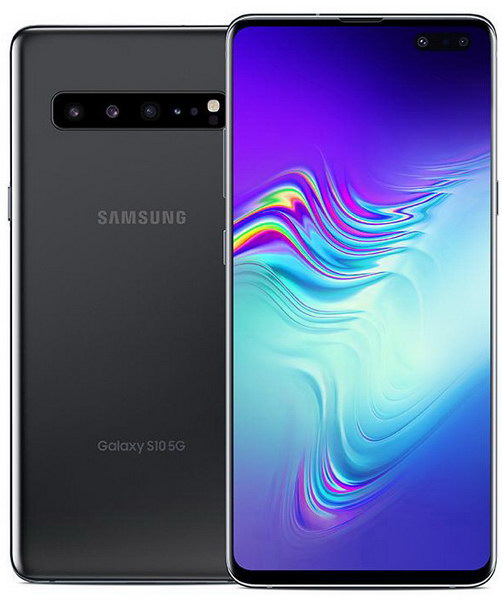 Samsung Galaxy S10 5G, available for pre-order through Verizon now. (Credit: Verizon)
Samsung Galaxy S10 5G, available for pre-order through Verizon now. (Credit: Verizon)
I’ve been asked by the SID Los Angeles chapter to present a webinar on 5G for their upcoming chapter meeting on May 9th. Anyone interested in learning more about the technology and business aspects of 5G and 5G NR, please make a reservation with Larry Iboshi at [email protected] to get the log-in information. Be warned: The webinar is scheduled for 7:30PM PDT, which is 10:30PM EDT. Ken has assured me he will be awake and tuned in. –Matthew Brennesholtz

